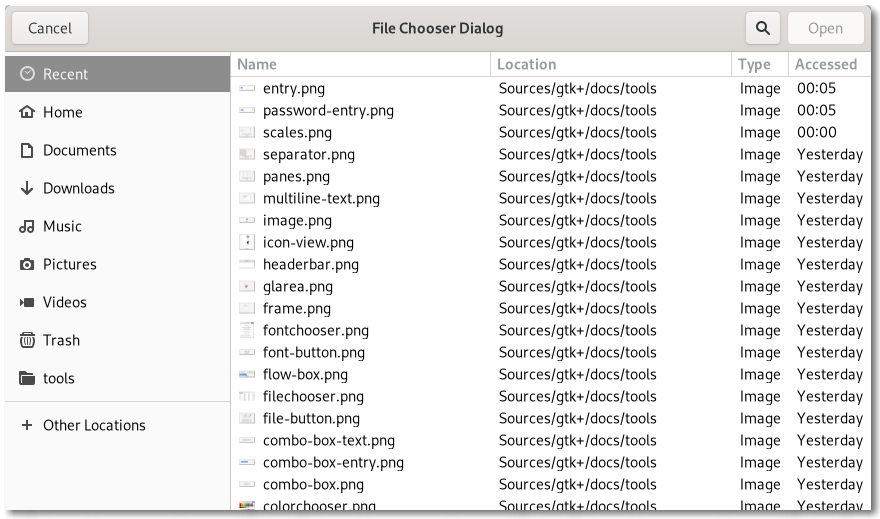FileChooserDialog
Deprecated since version 4.10: Use FileDialog instead
- class FileChooserDialog(*args, **kwargs)
Superclasses: Dialog, Window, Widget, InitiallyUnowned, Object
Implemented Interfaces: Accessible, Buildable, ConstraintTarget, FileChooser, Native, Root, ShortcutManager
GtkFileChooserDialog is a dialog suitable for use with
“File Open” or “File Save” commands.

This widget works by putting a FileChooserWidget
inside a Dialog. It exposes the FileChooser
interface, so you can use all of the FileChooser functions
on the file chooser dialog as well as those for Dialog.
Note that GtkFileChooserDialog does not have any methods of its
own. Instead, you should use the functions that work on a
FileChooser.
If you want to integrate well with the platform you should use the
FileChooserNative API, which will use a platform-specific
dialog if available and fall back to GtkFileChooserDialog
otherwise.
Typical usage
In the simplest of cases, you can the following code to use
GtkFileChooserDialog to select a file for opening:
static void
on_open_response (GtkDialog *dialog,
int response)
{
if (response == GTK_RESPONSE_ACCEPT)
{
GtkFileChooser *chooser = GTK_FILE_CHOOSER (dialog);
g_autoptr(GFile) file = gtk_file_chooser_get_file (chooser);
open_file (file);
}
gtk_window_destroy (GTK_WINDOW (dialog));
}
// ...
GtkWidget *dialog;
GtkFileChooserAction action = GTK_FILE_CHOOSER_ACTION_OPEN;
dialog = gtk_file_chooser_dialog_new ("Open File",
parent_window,
action,
_("_Cancel"),
GTK_RESPONSE_CANCEL,
_("_Open"),
GTK_RESPONSE_ACCEPT,
NULL);
gtk_window_present (GTK_WINDOW (dialog));
g_signal_connect (dialog, "response",
G_CALLBACK (on_open_response),
NULL);
To use a dialog for saving, you can use this:
static void
on_save_response (GtkDialog *dialog,
int response)
{
if (response == GTK_RESPONSE_ACCEPT)
{
GtkFileChooser *chooser = GTK_FILE_CHOOSER (dialog);
g_autoptr(GFile) file = gtk_file_chooser_get_file (chooser);
save_to_file (file);
}
gtk_window_destroy (GTK_WINDOW (dialog));
}
// ...
GtkWidget *dialog;
GtkFileChooser *chooser;
GtkFileChooserAction action = GTK_FILE_CHOOSER_ACTION_SAVE;
dialog = gtk_file_chooser_dialog_new ("Save File",
parent_window,
action,
_("_Cancel"),
GTK_RESPONSE_CANCEL,
_("_Save"),
GTK_RESPONSE_ACCEPT,
NULL);
chooser = GTK_FILE_CHOOSER (dialog);
if (user_edited_a_new_document)
gtk_file_chooser_set_current_name (chooser, _("Untitled document"));
else
gtk_file_chooser_set_file (chooser, existing_filename);
gtk_window_present (GTK_WINDOW (dialog));
g_signal_connect (dialog, "response",
G_CALLBACK (on_save_response),
NULL);
Setting up a file chooser dialog
There are various cases in which you may need to use a GtkFileChooserDialog:
To select a file for opening, use
OPEN.To save a file for the first time, use
SAVE, and suggest a name such as “Untitled” withset_current_name.To save a file under a different name, use
SAVE, and set the existing file withset_file.To choose a folder instead of a filem use
SELECT_FOLDER.
In general, you should only cause the file chooser to show a specific
folder when it is appropriate to use set_file,
i.e. when you are doing a “Save As” command and you already have a file
saved somewhere.
Response Codes
GtkFileChooserDialog inherits from Dialog, so buttons that
go in its action area have response codes such as ACCEPT and
CANCEL. For example, you could call
new as follows:
GtkWidget *dialog;
GtkFileChooserAction action = GTK_FILE_CHOOSER_ACTION_OPEN;
dialog = gtk_file_chooser_dialog_new ("Open File",
parent_window,
action,
_("_Cancel"),
GTK_RESPONSE_CANCEL,
_("_Open"),
GTK_RESPONSE_ACCEPT,
NULL);
This will create buttons for “Cancel” and “Open” that use predefined
response identifiers from ResponseType. For most dialog
boxes you can use your own custom response codes rather than the
ones in ResponseType, but GtkFileChooserDialog assumes that
its “accept”-type action, e.g. an “Open” or “Save” button,
will have one of the following response codes:
This is because GtkFileChooserDialog must intercept responses and switch
to folders if appropriate, rather than letting the dialog terminate — the
implementation uses these known response codes to know which responses can
be blocked if appropriate.
To summarize, make sure you use a predefined response code
when you use GtkFileChooserDialog to ensure proper operation.
CSS nodes
GtkFileChooserDialog has a single CSS node with the name window and style
class .filechooser.